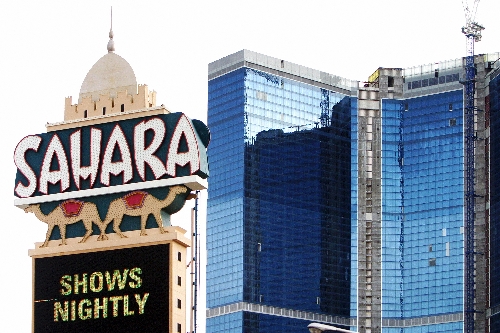Fontainebleau contractors share lessons from project failure
For Summit Partners, a startup company funded partly by tapping a home-equity loan, landing a contract with the massive Fontainebleau seemed like a vaccination against the standard growing pains.
But the outlook shifted dramatically a year ago, as the $3 billion project started to crack at its financial foundations without warning, leading to a halt in work and a Chapter 11 bankruptcy filing last June.
"We read about it in the paper just like everybody else," said John Georges, one of Summit's three founding partners.
By the time Fontainebleau was sold in January to New York investor Carl Icahn for $156.6 million, little more than scrap value, Georges had become reconciled to never seeing any of the $71,000 he was owed for computer hardware and software he supplied during construction.
Busts have long been the cost of doing business in growth areas like Las Vegas. However, Fontainebleau's implosion showered wreckage on contractors and suppliers such as Summit Partners on a scale well beyond what even long-timers can remember.
One document in Fontainebleau's bankruptcy case totaled the mechanics' liens and contractor claims at $424.3 million, with another $41.3 million in suppliers who were totally unsecured by collateral. One list of liens numbered 338 companies.
Attorneys in the case expect the numbers to come down as duplicate bills are weeded out and final amounts are established based on invoices. Still, the creditors list covers a broad swath of the construction industry, including material suppliers for everything from the floor to the roof and services ranging from overall design to the sports book system to green-building techniques.
All of them faced basically the same situation: What initially looked like a perfect wave suddenly morphed into a perfect storm. A high-value project, about 70 percent complete, with nothing behind it when the banks cut off funding and a new owner who has not revealed when, or if, he will restart construction all coalesced to create the massive losses. The other unfinished hulks in the valley were substantially smaller or had companies behind them to cover the bills, such as Boyd Gaming Corp. with its Echelon project across the Strip from Fontainebleau.
Adding to the problems was the speed of Fontainebleau's demise.
"It wasn't something anybody expected to go south," said Scott Howard, a principal at Commercial Roofers, which has filed a $4.3 million claim. "We had been given assurances that all the financing was in place. Then Fontainebleau just basically exploded."
Businesses had little or no time to take defensive measures, such as demanding cash upon delivery, he said. Business owners who went all-out to serve the customer found themselves in a deeper hole.
"When the lenders stopped funding, it was like a rear-end collision on a freeway that gets longer and longer because there is no time to stop," said Robert Meacham, a Fort Lauderdale, Fla., attorney representing some of the creditors.
While the businesses have generally written off all of what Fontainebleau owes them, Meacham called this "very premature." Because many vendors recorded liens before the mortgages, he believes they could jump ahead of the banks in the line to claim the approximately $100 million available for creditors. But the banks that are owed $2.1 billion have already filed papers showing they will fight doggedly for their repayment priority.
Even if the case succeeds, Meacham said, nobody should expect checks soon.
"Courts do not move quickly," he said.
The following are a sampling of the companies caught up in the Fontainebleau maelstrom and the lessons their executives learned.
SUMMIT PARTNERS
Summit, formed in 2008 by three information technology veterans, hit a pothole early on when a thief broke into its office and stole hardware.
However, losing $71,000 on Fontainebleau, an early big client, turned out to hurt much more.
At the time, Summit had other customers, giving the company a chance to regroup.
"If that were not true, we would not be in business today," said Georges.
That pushed the partners to shift their marketing approach.
"We learned we need to go after small and midsized businesses," Georges said. "There is less reward with them but there is also less risk."
The company has started to pursue more work with government entities, which he acknowledged have suffered budget problems.
COMMERCIAL ROOFERS
Change orders come with almost any construction project as on-the-fly adjustments that keep work going when the blueprints don't quite work in reality. But trying to do its part to keep Fontainebleau moving at an accelerated pace, Commercial Roofers agreed to do some oral change orders instead of insisting that all of them be put in writing.
When work stopped, the company could not prove that all the change orders were authorized.
"It was just a good wake-up call to make sure everything is in place," Howard said.
With its origins dating back to 1950, Commercial Roofers has been around long enough to go through a few cycles of the boom-bust Las Vegas economy. With that in mind, Howard said, the company a few years ago began structuring its balance sheet and building up reserves, expecting the building binge to someday end.
When it became apparent that it would lose $4.3 million on Fontainebleau, the company kept going.
"Maybe we didn't buy as many trucks last year as we would have, but work slowed down anyway," he said. "But that's $4 million we don't have to weather the downturn. Where that might affect us is if the economy doesn't turn around in the next couple of years."
But as far as other changes in the business operation, he added, "Whatever we could have done would have led to the same result."
RA ENERGIE
Shortly after moving here from France in the summer of 2007, Herve Mazzocco started RA Energie to tap growing demand for expertise in environmental building techniques and renewable energy. By the end of the year, he had signed with Fontainebleau to study several aspects of the building, including adequate air circulation to keep the casino smoke-free.
When work stopped, he found himself on the list of a dozen vendors whose work was considered critical. In particular, his data would be needed to secure the tax breaks that come with Leadership in Energy and Environmental Design certification as a green building, so the $16,000 he received covered almost all his work.
Still, he admits he became too comfortable as a businessman.
"It was easy to go to sleep in that position with a big company as a client and the money flowing in every month," he said. Without Fontainebleau, "It was rough for a while."
Nevertheless, he is one of the few that calls the experience "a blessing in disguise." He was able to get his name known professionally, which helped as he scouted for a broader customer base. He has also refocused on alternative energy, what he originally intended to do.
ITAL STONE
Gianfranco Ventre has started to see signs of economic recovery, but it may come too late for the natural stone contractor he has owned for 14 years.
If Fontainebleau someday opens, it will be with his flooring up to the 34th floor. But the $633,000 he has lost on the project could capsize the family-owned business well before then.
"I am on the verge of bankruptcy," he said of Ital Stone. "Business is picking up but we are getting no help from the banks."
If Ital Stone survives, Ventre promised to be much tougher on terms.
"It will be 50 percent of the money up front and the rest on delivery," he said. "That's it."
BERGMAN, WALLS & ASSOCIATES
Like RA Energie, Fontainebleau executive architect Bergman, Walls made the critical list of vendors. But after it was decided to put work on indefinite hold, the company lost its critical designation and has not received a dime of the $2.3 million it was owed.
There were times during the latter stages of construction when Fontainebleau started to drag out payments, but design work proceeded.
"We didn't want to be accused of holding up the job," principal Joel Bergman said. "In good faith, we gave them some drawings and the next thing you know it was over."
In the aftermath, the company cut its payroll from 120 people to 42, after staffing up for Fontainebleau. At one point, the project accounted for at least half of company revenues, Bergman said.
But in a market that has become "very, very, very competitive," he's not sure he would get tougher on future clients.
"You can be righteous as hell and believe in your heart of hearts that you will never let it happen again," he said. "You can stand astride your steed with your pearl-handled revolver and promise you will remain strong. But when you have to pay the rent and meet the payroll, who the hell knows what you will do at that point."
ENERGY & ENVIRONMENTAL SOLUTIONS
After consulting with clients on green-building techniques since 1993, firm President Christian Klehm received a refresher course from Fontainebleau.
Monocultures rarely last long in nature, he said, yet Energy & Environmental Solutions had become heavily dependent on one project.
"The one fundamental lesson of green building is that you succeed with diversification," he said.
Work stopped when the firm was owed $254,000, so he had to cut his staff from about 16 to 12 and hit the road to find new clients in places like California and the Midwest.
Perhaps more importantly, he went over every aspect of operations from the vantage point of what would happen if the order book were empty.
"What we have done is develop much more efficient approaches to work," he said.
But the wrenching experience has left its scars. "I can't call this a blessing in any way," he said. "There was too much pain for too many people."
RYAN GALLERY & PICTURE FRAMES
Owner Gail Buy received a call from Fontainebleau in March 2009 for mirror frames, requesting her to rush the delivery if possible. The check was being cut and sent on its way.
Eager to please a new client in a slow economy, she cooperated. But court documents show that the project had stopped paying most bills in February, leaving her with an unpaid claim of $13,000 plus thousands of feet of useless mirror framing. Because Ryan Gallery frames pictures, she could not reuse the Fontainebleau material for another client.
Because she had dealt with Steve Wynn-controlled entities for nearly two decades and never been stiffed, she decided to take a chance on Fontainebleau.
"You take people at their word," she said. "From now on, we will put new customers on trial accounts."
That will mean not extending payment terms to clients she hasn't dealt with before.
Contact reporter Tim O'Reiley at
toreiley@lvbusinesspress.com or 702-387-5290.





























